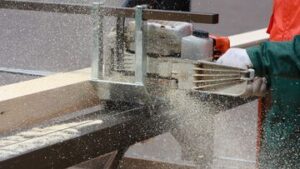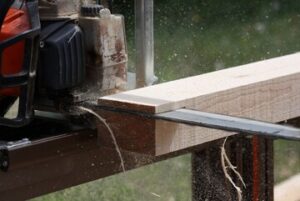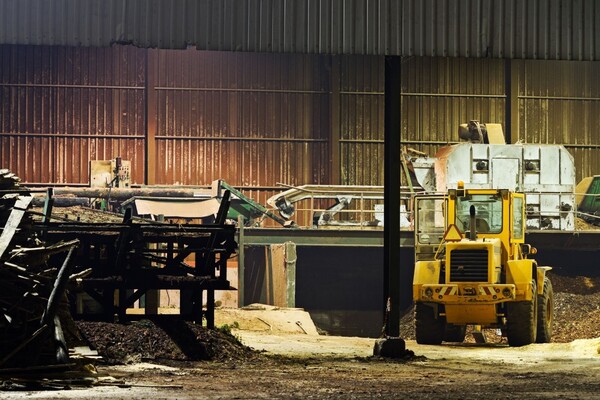Observe Proper Workplace Lightings & Noise Control
There is no fixed ordinance in the United States stating it is prohibited to chainsaw at night. However, in its Occupational Safety and Health Administration Standards, it was stated that sawmills must observe sufficient lightings during night operation and an effective noise-reduction system must be incorporated.
The only law that may affect you in operating your chainsaw mill at night is any local ordinance relating to noise levels after a certain time. Some city ordinances have max decibel levels even in daylight hours.
Most sawmills use different lightings inside their production area or installed at higher altitudes but connected to the sawmill machine. There are varieties of lamps to be used for your mills such as mercury vapor, fluorescent, or halide light bulbs. However, what is really recommended are LED lights for your sawmill night production.
Here are some the major benefits when you’ll use LED lightings for your sawmill production.
- Energy efficient: LED lights are 80% more efficient than other types of bulbs. Approximately, 95% of energy is converted to light while the remaining are dissipated as heat.
- Environment-friendly: It doesn’t contain any toxic compounds so it’s easy to dispose of.
- Brighter lights, Fewer LEDs needed: Because of its high-efficiency rating, you’ll only use a few LEDs inside your factory to keep a well-illuminated workplace.
- Longer Lifespan: LED lights are proven to have longer usable lifespan compared to other types. Other benefits from a longer lifespan is a lower carbon emission, thus, protecting the environment from further destruction.
Lighting Systems Best for Sawmills
Proper lighting conditions, particularly for night operation, is exemplified in the occupational health and safety standards for the United States. Below are some of the standards that must be met.
- Lux Level: The standard indoor lighting for any sawmill production are the following:
- 200 lux for log storage and corridor
- 300 lux for packaging and segregation area
- 500 lux for debarking and cutting area
- Glare-free: The presence of glare for the lightings used will harm the workers’ eyes. It is advisable to use LED lightings with 60% anti-glare lens.
- The absence of Shadow: The presence of shadow can interfere with the visibility of the control panels in operating the machinery. In order to secure zero shadows, a photometric plan must be done for the work area in the factory.
- Healthy Lightings: Some types of lamps such as mercury vapor and fluorescent emits certain amounts of UV. Long exposure to this kind of light will harm the health of workers. Choose LED lights for it doesn’t contain any toxic chemicals which pose health risks.
Do They Make Quieter Mufflers for the Chainsaw?
No, not off the shelf stuff. Your muffler and your carb tuning is closely related too by the way.
I have never seen it, but say for a chainsaw sawmill, I would think one could adapt a metal braided hose into a bucket, (or barrel) of water for reduced noise. However, if you are setting up semi-permanent, you probably could run electric, or a hydraulic driven chain.

The timber industry ranked second as a workplace exposure to a high noise level based on the 2nd European Survey on Working Conditions (ESWC). Chainsaw mill production
at night is regulated due to the disturbing effect of the high noise level.
What Part of a Sawmill is Noisiest?
In general, most sawmill factories generate around 80 dB to 120 dB of noise coming from a variety of parts and equipment. These noises are generated from the various operations which include transportation, unloading, loading of logs, cutting, stacking, fans, kiln motors, and various vehicles.
Bandsaw mills have an average noise level of 104 dBA while chainsaw mills are around 110 dBA. The recommended exposure time for a person is 2 to 6 minutes for the band saw while 1 to 1.5 minutes for chainsaw mills.
In the three main parts of a sawmill, there is already a stipulated noise level boundary. For the production area and warehouses, the maximum noise level must be at 85 dBA while 55 dBA for the offices.
Some chainsaw mill units have built-in mufflers in their engine but still produce a disturbing amount of noise. If the existing muffler of the engine doesn’t effectively remove noise, then attaching a supplement muffler is not hard to do really.
Here are some practical maintenance tips to minimize the noise level of chainsaws:
- Maintain appropriate blade tension and lubrication to smoother operation.
- Have a constant period for cleaning and replacing the air filter
- Make sure the engine is well-maintained and runs smoothly during operation
- Ensure the muffler is properly bolted at the side of the engine cylinder and that there are no loose internal baffles loose inside the muffler..
What Does A Chain Saw Muffler Really Do?
It actually has 2 parts, or 3 things it has to do.
- Reduce the noise level coming from combustion.
- Arrest sparks (hot pieces of carbon) that could make there way to dry leaves and start fires.
- The third is allow the exhaust volume to flow without restriction.
The third one, not to reduce exhaust volume is a give in, or it won’t run. Often when your mixed gas may be mixed a little oil heavy, it can start to clog the arrestor screen and make the engine dog down. Simply inserting a new, or cleaning the old arrestor allows air flow, and restores engine power.
We say this because, designing something that in essence restricts flow by making it bounce around and reduce its loudness and not reducing volume of flow is not the easiest thing in the world.
What are other ways to minimize noise and vibration in sawmill production?
If the built-in and DIY muffler doesn’t effectively remove noise and vibration, there are other techniques you can do. Here are some of the practical ways of minimizing the noise and vibration of a sawmill factory.
Treating the Room
In order to make the room soundproof, you can install panels and baffles so that it will absorb noise and convert it to kinetic energy.
Installing noise dampening materials on the wall
Install acoustic foam panels on the wall nearest the source of the noise. This reduces the noise level by 2 to 6 decibels. Likewise, this method is pretty much affordable.
Barrier and shield around the engine
One can create a wall to isolate the noisy equipment and engine and install acoustic foam panels inside to reduce the amount of noise released to the environment.
Could be simple as man making hills around the outskirts of the property, so the sound hits the hill and bounces of in the air away from ears not at the mill!
How much ventilation Do I Need to run A Chainsaw mill inside?
To maintain a healthy and safe working environment, sufficient air must be present inside the workplace. In every sawmill, ventilation must be well-observed and this can be done through the following steps:
- Vents must be located in every building and special sheds. Humidity level must also be observed in cold season.
- Sawmills must have high ceilings to allow more space for air circulation
- Several roof ventilators or louvers is also advisable
- If the sawmill factory has a low ceiling, then exhaust fans must be installed
Dust Collection Systems
This is responsible for the collection of all dust particles produced in the production area. A sawmill dust collection system consists of exhaust vent hoods, duct pipes, and dust collectors. This system plays a critical role in preventing ignition or production of flame inside the factory.
How Many Decibels Does a Chainsaw Make
A chainsaw mill has an average noise level of 110 dBA. Exposure to this noise level over the duration of 1 to 1.5 minutes will start to cause detrimental effects. Wearing hearing protection of course lowers the decibels so you can work longer. Being farther away can lower the decibels as well.

When Does Hearing Loss Occur with a Chainsaw?
A repetitive and long hour exposure for chainsaw mills poses a higher risk for hearing impairment. The suggested exposure time for chainsaw mill is around 1 to 1.5 minutes only. However, this is impossible in the industry because workers need to be there for 8 hours or more.
Most studies have said that continuous exposure to a noise level higher than 85 to 90 dBA poses higher chances of hearing impairment. Approximately, 72.5 percent of sawmill workers suffer from hearing loss.
Further, a 3 dB increase in noise level is equivalent to twice the sound energy generated by any equipment or sound source.
What is the Biggest Electric ChainSaw? (if needed)
Most powerful electric chainsaws have an engine power that equals their gas-powered cousin class between 35 to 42 cc with a 15-amp motor specification. Their average weight is around 10 to 15 lbs depending on the engine or motor and if it is cordless, the weight of the battery also adds to the burden.
Conclusion to Chain Saw sawmill Noise Levels
Electric motor chain saws are the quietest chain saw. Cordless fall in this realm too, however a cordless saw does not have the continuous run time a chain saw mill needs typically.
If you need any help or further information, please feel free to access our other articles.
You may also contact us any time and we will do our best to answer any of your concerns in the shortest turn around time possible.

